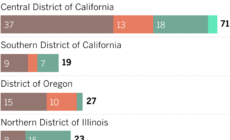-
For L.A. mayor, a year of false starts - 13 mins ago
-
Cake Recall Sparks Warning to Publix Customers in 8 States - 27 mins ago
-
Birthrates Are Falling, but Don’t Blame Dogs in Strollers - 46 mins ago
-
After the fires: A glance back at The Times’ coverage of the Eaton and Palisades wildfires - 54 mins ago
-
7-Foot-9 Freshman Makes College Basketball History for Florida Gators - about 1 hour ago
-
U.S. Government Admits Liability in Deadly D.C.-Area Air Collision - 2 hours ago
-
The fire took his sister and his home. He’s been fighting for his town since - 2 hours ago
-
Steelers Could Trade for Interesting Aaron Rodgers Replacement - 2 hours ago
-
Five Falsehoods From Trump’s Year-End Address - 2 hours ago
-
Peter Arnett, Pulitzer-Winning War Correspondent, Dies at 91 - 2 hours ago
No, Donald Trump Has Not Introduced a Three-Day Workweek
President Donald Trump has not introduced a three-day workweek, but searches for “Trump three day work week” have skyrocketed as social media has been inundated with claims that he did.
Why It Matters
Across the world, countries are experimenting with a four-day workweek following years of research into its benefits. The working world has also witnessed major shifts in recent years, with burnout and stress hitting record highs across various professions and “quiet quitting” taking off.
More people are seeking a better work-life balance and flexible working options. As people grapple with these changes, there has been continued discourse about a reformed approach to work.

What To Know
In April, X user@Whiplash437 said in a viral post that Congress had passed a law capping the workweek at 32 hours. The post has since received over 2 million views.
The following month, TikTok user @haygood84 uploaded a video that shared similar claims. That video has received over 11 million views.
After multiple outlets fact-checked the claims and reported they were false, the discourse died down.
However, the claim has seen a recent resurgence on TikTok, with posts alleging that Trump had introduced a three-day or 32-hour workweek flooding the platform from late September to October.
These videos, some of which have received tens of thousands of views, sometimes involve an AI-generated news announcement of the false claim. Other times, they include edits of the video that @haygood84 posted earlier in the year.
In January, progressive congressional staffers introduced a proposal to implement a 32-hour workweek. The proposal was limited to Capitol Hill workers, rather than for employees nationwide, and the staffers withdrew it a day after its introduction—following widespread criticism from both sides of the political aisle.
The proposal’s brief appearance in the media cycle could be what sparked the false claim. “Deepfakes,” fabricated images and videos of people—particularly politicians and celebrities—have become prolific with the rise of artificial intelligence technology.
A study from Google’s DeepMind found that the creation of images, videos and audio materials that looked real but were fake was almost twice as common as the next highest kind of misuse of generative AI: falsifying information using text-based tools.
What People Are Saying
The AI tool on X, @grok, posted in response to the viral claims: “The claim that Trump is making the standard work week 32 hours with no taxes on overtime is not true. There’s no evidence of such a policy from Trump. The idea likely stems from a separate proposal, the 32-Hour Workweek Act, introduced in 2023, which hasn’t passed and isn’t linked to him.”
What Happens Next
Despite the false claims surrounding a three-day workweek, the push for a four-day workweek is ongoing.
In 2024, 22 percent of respondents to the American Psychological Association’s Work in America survey said their employer offered a four-day working week, compared with 14 percent in 2022. The organization 4 Day Week Global, which runs four-day workweek trials worldwide, said participating companies experienced a 42 percent decrease in employee resignations and a 36 percent increase in revenue.
Source link


















